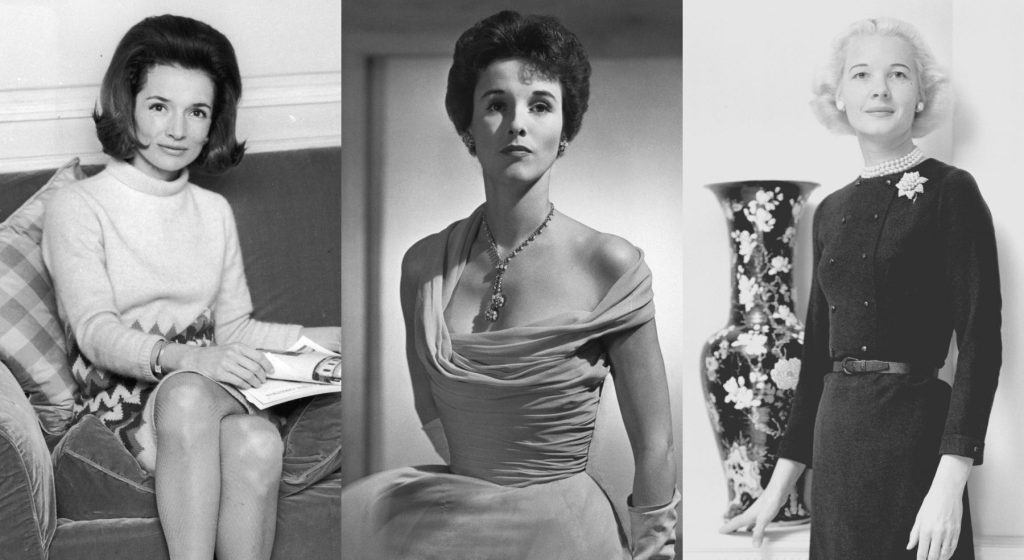Seven years after the premiere of Ryan Murphy’s “Feud,” the anthology’s second season — out Jan. 31 — charts the fascinating lives of Truman Capote’s muses. Subtitled “Capote vs. The Swans,” Murphy’s new installment surrounds the author’s high society pals, whose secrets he would eventually expose in the 1975 Esquire article “La Côte Basque, 1965.”
The piece was an excerpt from “Answered Prayers,” a roman à clef that Capote once called his magnum opus. The finished novel never made it to publication, yet its legend lives on: the dissolution of Capote’s closest friendships were chronicled in Lawrence Leamer’s 2021 volume “Capote’s Women: A True Story of Love, Betrayal and a Swan Song for an Era,” which serves as the source material for “Feud.”

To Capote, they were “swans”; to the press, they were the “ladies who lunch” — and lunch they did, most notably at storied institutions like Colony Club, Le Cirque and La Côte Basque, where the infamous excerpt got its name.
Among those swans, Lee Radziwill, C.Z. Guest, Slim Keith and Babe Paley, were celebrated socialites, trendsetters and fashion icons whose influence still resonates today. The wardrobes of Radziwill and Paley inspired Lanvin’s spring 2020 collection, while Guest was the first recipient of the CFDA’s coveted Fashion Icon Award — an honor later bestowed upon Rihanna, Kate Moss and Sarah Jessica Parker.
Babe Paley

Babe Paley was groomed as a debutante before she began working at Vogue in 1938. She parlayed her status as a fashion editor into a certified style icon, making numerous best dressed lists and earning an induction into the International Best Dressed List Hall of Fame in 1958.
The wife of CBS founder William “Bill” S. Paley, Babe Paley made pantsuits and tying scarves to handbags trendy. When she let her hair go gray, emulators all but abandoned their dyeing rituals. Paley’s wardrobe brimmed with Balenciaga, Valentino and Givenchy; she frequently paired Schlumberger and Verdura sparkle with costume jewels.
Paley was Capote’s closest confidante, and his most prized swan. “She was one of the two or three great obsessions of my life,” Capote once said. “She was the only person in my whole life that I liked everything about.”

Capote’s and Paley’s kinship crumbled following the publication of “La Côte Basque.” The writer portrayed Bill, disguised with the pseudonym Sidney Dillon, as a philanderer — revealing the couple’s secretly troubled union to the entirety of high society. Once Capote’s piece hit the stands, Babe never talked to him again. She died of lung cancer in 1978, and Capote wasn’t invited to the funeral.
In “Feud,” Paley is played by Naomi Watts.
C.Z. Guest

C.Z. Guest, the ash blond Boston Brahmin, became an emblem of the elite after covering Time in 1962. Regarding her presence at social events, the magazine proclaimed: “If she wasn’t there, it doesn’t exist.”
C.Z. married polo champion Winston Frederick Churchill Guest, a distant cousin of the British Prime Minister, at Ernest Hemingway’s Havana estate. The bride wore Mainbocher; Hemingway served as best man.
Considered one of the most stylish women of the ’50s, Guest made the Fashion Hall of Fame in 1959. A renaissance muse, she influenced designers like Bill Blass and Ralph Lauren and posed for painted works by Salvador Dalí and Diego Rivera.
Writer Jill Gerston famously described Guest as being “cut from the same cool, silky cloth as Grace Kelly…a patrician beauty that is indigenous to socially registered enclaves like Palm Beach and Southampton, a sporty, outdoorsy look that eschews makeup, hairspray and anything trendy.”

Among her flairs for the “outdoorsy” included passions for horticulture and horseback riding. Following a bad fall, Guest became a gardening columnist for the New York Post, authoring her first book on the subject a decade later.
Guest also took interest in interior design, tapping the talents of Stéphane Boudin to decorate Templeton, her 12,000-square-foot, 28-room brick mansion in Old Westbury, N.Y.
The socialite later dabbled in fashion design, debuting a collection of cashmere sweaters during Adolfo’s fall 1985 show — but she never abandoned her role as muse, walking for Prada at the age of 74.
Guest was one of the few loyalists who didn’t shun Capote post “La Côte Basque.”
Chloë Sevigny is cast as Guest in season two of “Feud.”
Lee Radziwill

She’s been called the “original influencer” — Lee Radziwill, the sister of Jackie Kennedy, was one of the best-known socialites of her time. A former assistant to Vogue editor Diana Vreeland, Radziwill’s sophisticated taste shaped Jackie’s reputation as first lady. When President John F. Kennedy demanded that his wife only wear American designers, Radziwill smuggled Givenchy gowns into the White House for her younger sister.
“Lee had a huge influence on Jackie, and a lot of her style was filtered down from Lee,” designer Martin Grant said in Radziwill’s New York Times obituary.
Radziwill’s penchant for streamlined clothes, oversize sunglasses and free-flowing hair were trends adopted by Jackie, and eventually, the world. In 1962, she was voted one of the world’s best dressed women in an international fashion poll, making the Best Dressed List’s Hall of Fame in 1996.
“She edited out the excess,” added André Leon Talley, who first met Radziwill while working for WWD in the ’70s. “She told me she’d never had an Hermès bag or silk scarf in her life. Everyone else carried them, so to her they were common.”

Radziwill frequently opted for looks from Givenchy, Halston, Giorgio Armani and Courrèges — the latter of which she helped popularize. In the ’80s, she became a public relations executive for Armani. Radziwill is largely credited with raising the designer’s profile among the high society and celebrity sets. “It was about simple, low-key things and a great respect for line and beauty,” she once said of the brand.
At the urging of her good friend, Capote, Radziwill embarked on an unsuccessful acting career in the ’60s before setting her sights on interior design. Her taste was heavily influenced by Italian architect Lorenzo Mongiardino, whom Radziwill tapped to decorate the London residence she shared with her second husband, Polish aristocrat Prince Stanisław Albrecht Radziwill. Lee’s fervor for furbishing never faded — she even helped her good friend, designer Marc Jacobs, select linens and dishes for his Parisian abode.
Radziwill is directly mentioned in “La Côte Basque,” though she continued to defend Capote following its publication. She later admitted that she felt the writer had been “taken advantage of by a lot of people he thought were his friends,” according to a 2012 Vanity Fair article.
Calista Flockhart portrays Radziwill in “Feud.”
Slim Keith

By the time Nancy “Slim” Keith, born Mary Raye Gross, was in her late teens, she was hobnobbing with Hollywood royalty. At the age of 22, she made the cover of Harper’s Bazaar. ”I have a tall, skinny frame that clothes look well on,” Keith said in 1946 — but that wasn’t how she got the nickname Slim.
While vacationing in Death Valley, Keith crossed paths with William Powell. After the actor spotted her diving into the pool at the Furnace Creek Inn and Ranch Resort, he christened Keith with her distinctive moniker. It was through Powell that she was introduced to Hollywood’s haut monde, including her first husband, filmmaker Howard Hawks.
Hawks modeled several of his iconic femme fatales after Keith, most notably Lauren Bacall’s straight-talking, smooth-dressing character in “To Have and Have Not.” Keith was later credited with discovering Bacall, who she first spotted on the cover of Vogue.
In 1946, Keith, then Mrs. Slim Hawks, was named the best dressed woman of the year by 150 fashion editors. Wallis, the Duchess of Windsor, was her runner-up. Keith, who has since been crowned the original “California Girl,” favored an equestrienne look consisting of riding jackets, tailored trousers and upswept hair.

“It was about good looks, brains, taste and style…,” Keith wrote in her 1990 memoir, “Slim: Memories of a Rich and Imperfect Life.” “The only ingredient I brought to this recipe was the recognition that, while you have to be natural, you also have to be different. In my day, different meant not having your hair done in a pompadour and adorning it with a snood, or not trying to hide your intelligence behind a sea of frills. I opted for a scrubbed-clean, polished look. I thought it was more important to have an intelligence that showed, a humor that never failed, and a healthy interest in men.”
Men, as it turns out, also had a healthy interest in Keith. In her youth, she was courted by Clark Gable and Ernest Hemingway before being pursued by her second husband, Broadway agent and producer Leland Hayward. Upon her third marriage to Sir Kenneth Keith, a British banker and knight, Slim earned the title of Lady Keith.
Keith completely ostracized Capote after “La Côte Basque” was published. She served as a stand-in for the excerpt’s lead character, Lady Ina Coolbirth, who was portrayed as a zealous gossip — and a lush.
In season two of “Feud,” Diane Lane stars as Keith.
Ann Woodward

Perhaps the most scandal-plagued of Capote’s muses was Ann Woodward, a socialite, actress and dancer who would go on to commit “The Shooting of the Century.”
In 1937, Woodward moved to New York City after she was scouted by the John Robert Powers modeling agency. She picked up acting work on the airwaves and was named “The Most Beautiful Girl in Radio” in 1940.
While performing as a showgirl at the trendy Midtown hot spot FeFe’s Monte Carlo, she was introduced to a wealthy banker named William Woodward Sr. It’s rumored that she began an affair with him before she was eventually wooed by his son, William Woodward Jr. Ann’s reputation initially made her reviled by high society, though she would later be welcomed into the elite fold.
The Woodward name was scathed yet again in 1955, when Ann shot and killed William Jr., who she claimed to have mistaken for a burglar. She was never charged or convicted for the crime, but this didn’t stop many of her upper crust peers from suspecting foul play.

A year later, Capote encountered Woodward in a restaurant in Saint Moritz. Following a brief conversation, she hurled a slur at the writer, who cheekily retorted by calling her “Mrs. Bang Bang.”
Capote barely bothered to conceal Woodward’s identity in “La Côte Basque.” The character Ann Hopkins, who is lampooned as a gold digger, murders her husband in cold blood.
Woodward caught wind of the Esquire article before its release, committing suicide just three weeks ahead of the issue’s publication.
Demi Moore is set to play Woodward in “Feud.”
Joanne Carson

Joanne Carson, the ex-wife of Johnny Carson, married the comedian just one year after he began hosting “The Tonight Show.” Following their divorce in 1972, Joanne grew close with Capote, who had been a frequent guest on her husband’s program.
“Everyone moved toward Johnny [after the divorce], because that was where the power was,” Carson told the Los Angeles Times in 2006. “But Truman stood by me like a rock.”
Joanne, in turn, stood by Capote when most of his swans abandoned him. She, too, was a character in “La Côte Basque,” as was her ex-husband. Fictionalized as Bobby and Jane Baxter, the former, described as a “midnight-TV clown,” phones his wife, Jane, as he lies in bed with his mistress.

Nevertheless, Carson forgave Capote for his less than flattering portrayal of her marriage. He even made himself at home in her Bel-Air estate, where she moved just a year before her divorce was finalized. Capote would eventually die there in 1984. Carson was with him when he took his last breath.
Carson kept half of Capote’s ashes — the rest went to his partner of over three decades, John Dunphy. Some of them were kept in a Japanese box on Carson’s mantle until her death in 2015, when they were auctioned off for nearly $45,000. The final quarter of Capote’s ashes are interred with Carson’s at Westwood Cemetery in Los Angeles.
Molly Ringwald takes on the role of Carson in “Feud.”



